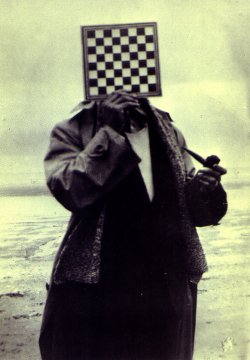 OPEN
CHESS DIARY 201-220
OPEN
CHESS DIARY 201-220
30 January - 11 July 2003
Previous entries | Next entries | Current Open Chess Diary
220. 11 July 2003: Anticipated cook
White to play and win
T. Gorgiev, G.Preuyt
First Prize Tijdschrift KNSB, 1959
In this week's "Instructor" column at
The Chess Cafe, Mark Dvoretsky shows a beautiful cook of a famous study
by Gorgiev and Preuyt. It had been found, he said (as he had already in
May in the Russian magazine Shakhmatnaya Nedelya; thanks to René Olthof
for pointing this out) by the young grandmaster Vladimir Potkin - blindfold.
Bravo Vladimir! - but just as endgames studies themselves, cooks can
be anticipated. And this cook, almost a study in itself, had already been found by
the Dutch endgame guru Harold van der Heijden, and was published on my site over
a year ago - see Krakingen
(cooks).
The author's solution is: 1.Ne3 f1Q+ 2.Nxf1 Rxf1+ 3.Ke2 Rf2+ 4.Ke1 Rb2 5.Ne6 Bf2+ 6.Kd1 Bg3 7.f7 Rf2 8.Nf4 Rxf4 9.b8Q Rf1+ 10.Ke2 Rf2+ 11.Ke3 Bxb8 and now 12.c7 wins, when 12.Kxf2 only draws: 12...Ba7 13.f8B (13.f8Q Bxc5+ 14.Qxc5 stalemate) Bb6 (13...Bb8 14.Bd6) and White cannot win, e.g. 14.Bd6 Ba5 15.c7 Kb7.
But there is a major flaw, which was also overlooked
by John Nunn in his recent book Endgame Challenge. On the sixth move
(see diagram), Van der Heijden deviates with 6...Be3! (instead of Bg3)
- and White cannot win: 7.f7 Bh6 8.Nd8 Or 8.f8Q Bxf8 and now
9.Nxf8 Rxb7 10.cxb7 Kxb7 11.Ne6 Kc6 12.Kc2 Kd5 13.Kd3 Kxe6 14.Kc4 Kd7 draw
or 9.Nd8 Rxb7 10.cxb7 Ka7 11.c6 Bd6 12.Ne6 Kb6 13.Nd4 Kc5, also with a draw
8...Rd2+ 9.Ke1 Rxd8 10.c7 (see diagram on the right) and now
Prokeš' idea:
10...Rd1+! 11.Kxd1 Kxb7 draw.
Another matter is that neither Dvoretsky nor Nunn seems to be aware of the
unique history of cooks and countercooks that this study had already been through.
In fact, one might wonder how the
unknown Preuyt got to be a co-author with the famous composer Gorgiev. The answer
is in the position that arises after 11...Bxb8 in the author's solution above.
Position after 11...Bxb8
Originally the study was published by Gorgiev alone in the Dutch Tijdschrift KNSB
for June 1958, and at this point his solution
ran: 12.Kxf2 Ba7! and now 13.f8Q Bxc5+ 14.Qxc5 is
stalemate, but after 13.f8B! Black is in Zugzwang: 13...Bb8 14.Bd6 and White wins.
But a solver, the Dutch musician Preuyt, discovered
that in this last line, instead of 13...Bb8?, Black can draw with 13...Bb6!
After 14.cxb6 Kxb6 White loses his last pawn; 14.Ke3 is met by Kb5, and
14.Bd6 Ba5 15.c7 Kb7 is also a draw.
When Gorgiev was informed of this, he hung his painting
upside down, and published the study as a draw in the September 1958 issue of
Tijdschrift, mentioning Preuyt as his co-author.
White to play and draw
T. Gorgiev , G.Preuyt
First Prize, Tijdschrift KNSB 1958
1.c7 Nd6 2.c8Q+ Nxc8 3.Rxc8+ Kd7 4.Rc7+ Kd8 5.Rg7 Nd3 6.Bxa7 c2 7.Bb6+ Ke8 8.Rc7 Nc5 9.Rxc5 g1Q 10.Rc8+ Kd7 11.Rc7+ Kd6 12.Bxg1 Kxc7 13.Lh2 c1B 14.Bg3 Kd6 15.Kg4 draw
This version won First Prize in the Tijdschrift's studies' section for 1958.
In a collection of his studies, Gorgiev gave 14.Bg3 two exclamation marks, without
mentioning Preuyt who had found this move.
But Preuyt made a new discovery: in the drawing version,
Black can still win with 12...f2! Which meant he had countercooked his own cook and that
the original version was correct after all;
in the diagram after 11...Bxb8, White can win with 12.c7!
The drawing version, now incorrect, was stricken from
the 1958 award.
Unperturbed however, Gorgiev submitted his study again, once more
as a win, and with the solution as given at the start of this item.
Even with the Bishop promotion relegated to a side variation,
it won First Prize for 1959, and became well-known (be it often without
mention of Preuyt), as a masterpiece of endgame composition.
Until Van der Heijden demolished it for good.
PS 28 July: In that same Shakhmatnaya Nedelya issue, Van der Heijden
spotted a repair by Andrei Visokosov that might just be the final and correct
version.
White to play and win
Andrei Visokosov (after T. Gorgiev & G. Preuyt)
Shakhmatnaya Nedelya, 2003
1.Ne6! And not 1.Nd7 Bg3+ 2.Kd1 h2 3.Nxh2 Rxh2 4.f7 Rf2 5.f8Q Rxf8 6.Nxf8 Kb5 7.Nd7 Kxc6, or 1.Ng6 Rxc5 2.f7 Rf5 3.f8Q Rxf8 4.Nxf8 Kb6, or 1.f7 Bg3+ 2.Kd1 Rxc5 3.Nd7 Rf5 4.b8Q Bxb8 5.Nxb8+ Kb6, all with a draw. 1...Bg3+ 2.Kd1 Not 2.Kf1 h2 3.Nxh2 Rxh2 4.b8Q and now 4.Kg1 Rh7 5.Kg2 Bb8 6.Nf8 Rh8 7.Nd7 Bc7 8.f7 Kb5 or 4...Bxb8 5.c7 Bxc7 6.Nxc7+ Kb7 7.f7 Rh8 8.Ne6 Kc6 9.Ke2 Kd7, both with a draw. 2... h2 3.Nxh2 3.b8N+? Bxb8 4.Nxh2 Rxh2 5.c7 Bxc7 6.Nxc7+ Kb7 draw. 3...Rxh2 4.f7 Rf2 Or 4...Rh8 5.Kc2 Kb5 and White wins both after 5...Bh2 6.Kd3 Bb8 7.Ke4 Rh4+ 8.Kf5 Rh8 9.f8Q and 6.c7 Bxc7 7.Nxc7+ Kc6 8.b8Q Rxb8 9.Ne8 etc. And now 5.Nf4 and the rest as above.
Is this the final, uncookable version?
219. 19 June 2003: LarryC's antidote to chessdepression
From the ICC-library of LarryC (Larry Christiansen):
LarryC - SongLo209, ICC 1 0, 25 May 2003
1.e4 g6 2.d4 Bg7 3.Nf3 d6 4.Bd3 a6 5.O-O b5 6.Re1 e6 7.a4 b4 8.Nbd2 Ne7
9.Nb3 O-O 10.a5 Nd7 11.Bf4 Rb8 12.Qd2 Re8 13.Bh6 Bh8 14.h3 c5 15.dxc5 dxc5
16.Rad1 Bxb2 17.Qf4 Bc3 18.Bc4 Ra8 (see diagram)
19.Qxf7+ Kxf7 20.Bxe6+ Kxe6 21.Ng5+ Kf6 22.Rd6+ Ke5 23.Nf7 mate
It's hardly justified to analyse a 1 0 game, but for the sake of truth, a few
comments by Fritz:
-- 20.Bxe6+ is a losing move, where 20.Ng5+ wins: 20...Kf6 21.Nxh7+ Kf7
22.Bxe6+ Kxe6 23.Ng5+ Ke5 24.f4+ Kxf4 25.Nf7+ Kg3 26.Re3+ Kh4 27.Bg5+ Kh5 28.g4 mate, or:
20...Kg8 21.Bxe6+ Kh8 22.Nf7+ Kg8 23.Nxd8+ Kh8 24.Nf7+ Kg8 25.Nd6+
Kh8 26.Nxe8 etc.
-- 20...Kf6! and Black is winning.
-- Or 21...Ke5 22.f4+ Kxf4 23.Nf7+ Kg3 24.Re3+ Kh4 25.Bg5+ Kh5 26.g4 mate
Thanks to Robert Ruonala for tipping me about this game which "made me love chess again after a period of 'chessdepression'," as he wrote.
218. 16 June 2003: Steel king from Utrecht
Johan Hut sent me a game, played yesterday in the Utrecht Open, in which a nice example of one of my favorite themes, the Steel King (I much prefer the Dutch 'winnende wandelkoning', but winning wanderking seems strange English) occurred.
Konings (2211) - Tuvshintogs (2193), Utrecht, 15 June 2003
Black (first name: Batceceg) is a WIM from Mongolia, White a strong player
from Utrecht with an appropriate name.
1.d4 d5 2.Nf3 Nf6 3.c4 c6 4.Nc3 dxc4 5.a4 Bf5 6.Nh4 Bg4 7.h3 Bh5 8.g4
Bg6 9.Nxg6 hxg6 10.e3 e6 11.Bxc4 Nbd7 12.Kf1 Bb4 13.Kg2 Qe7 14.f4 Nb6 15.
Be2 O-O 16.h4 Rfd8 17.h5 gxh5 18.g5 Nfd5 19.Ne4 g6 20.Bxh5 Kg7 21.Be2 Rh8
22.Rxh8 Rxh8 23.a5 Nc8 24.a6 b6 25.Nf2 Bd6 26.Nd3 Qc7 27.Qf1 Nb4 28.Nxb4
Bxb4 29.e4 Ne7 30.Be3 Qd7 31.Qf3 Qd6 32.Rd1 Rh7 33.Bc4 Qc7 34.Bb3 Qc8 35.
d5 cxd5 36.Bd4+ Kg8 37.Bf6 Qxa6 38.f5 gxf5 39.exd5 Ng6 (see diagram)
40.dxe6 Even if this is obvious and almost forced, it's a miracle that the white
King escapes from the shower of checks he will be exposed to.
40...Nh4+ 41.Kg3 Nxf3 42.Rd8+ Bf8 43.e7 Rh3+ Black always has to sacrifice
Rook and Knight to keep giving check. 43...f4+ 44.Kxf4 Rh4+ 45.Kg3 Rh3+
46.Kxh3 Qf1+ 47.Kg3 boils down to the same 44.Kxh3 Qf1+ 45.Kg3 f4+ Or 45...Qe1+
46.Kxf3 Qe4+ 47.Kf2 or 45...Qg1+
46.Kxf3 etc. 46.Kg4 Nh2+ (46...Qg2+ 47.Kxf4) 47.Kf5 Qh3+
48.Ke5 Qe3+ 49.Kd6 Qc5+ 50.Kd7 (see diagram) and Black resigned; after
Qf(b)5+ 52.Kc7 Qc5+ 53.Kb7 the King is finally safe.
The game received the prize for the most spectacular game in the tournament.
217. 9 June 2003: Chess Duke threatens internet
 Right behind Kieseritzky, the Duke of Brunswick
(Karl II, Herzog von Braunschweig, 1804-1873) is an Immortal Loser in Chess.
In consultation with Count Isouard, he lost what is sometimes called the most
famous game ever played; the "Opera Game" in the Paris Opera House in 1858,
against Morphy.
Right behind Kieseritzky, the Duke of Brunswick
(Karl II, Herzog von Braunschweig, 1804-1873) is an Immortal Loser in Chess.
In consultation with Count Isouard, he lost what is sometimes called the most
famous game ever played; the "Opera Game" in the Paris Opera House in 1858,
against Morphy.
As I discovered thanks to Aidan McGee, our own chess-Duke is also
immortal, in this case as a winner, in British and Commonwealth law. The ancient case (from
1849) Duke of Brunswick vs. Harmer was successfully cited in a few recent
libel cases, and might even threaten the freedom of speech and information on
the Internet.
In 1849, when he lived in London, the Duke sent his manservant out for a
back issue from 1832 of a small paper, the Weekly Dispatch, with a
defamatory article about him. The servant obtained two copies, one from the
offices of the Weekly Dispatch itself, and one from the British Museum. When
the Duke used these to sue the paper, it argued that the one-year limitation period
had expired, but the Court ruled that the servant's purchases constituted two fresh
publications of the article. Even if seventeen years had passed since the
original publication, the Duke could sue. He was awarded 500 pounds, a huge sum at
the time.
Duke of Brunswick vs. Harmer is still being cited
by lawyers and allowed by judges in Britain and the Commonwealth, most recently
in Australia in a libel case Gutnick vs. Dow Jones. In an American online
magazine, Dow Jones had suggested that the Australian mining magnate Gutnick had
been a customer of a convicted money-launderer. When Gutnick sued, Dow Jones wanted
the case to be tried in the US, but Gutnick's lawyers successfully cited the 1849
Duke of Brunswick case rule, to hold that that the article was published again at the
time and the place where it was downloaded.
In other words, the Duke is a threat to online archives - to
any online publication. If a new one-year limitation period starts with every download,
especially archives might feel the risk of libel claims from countries where the
Duke-ruling applies, is too great.
The Duke had a difficult life. After the early deaths of both of his parents, he
ascended to the Braunschweig throne in 1826, at 22. His 'awkward style of reigning
and his neo-absolutist regime' led to a revolution and his deposition in 1830.
He fled to Londen and lived the rest of his life in exile, always vainly trying to
regain the throne - that Weekly Dispatch article in 1832 must have had something
to do with that.
Karl's younger brother Wilhelm was put in his place and
in 1831 Karl II was declared 'unfit to rule' by the united German nations, a verdict
that was never lifted. When the unmarried Karl died in 1873 in Geneva (where he was
known as the Diamond Duke), he left his large fortune to this city. There is
a statue of him in front of Hotel Beaurivage.
Morphy - Duke of Brunswick and Count Isouard, Paris 1858
1.e4 e5 2.Nf3 d6 3.d4 Bg4 4.dxe5 Bxf3 5.Qxf3 dxe5 6.Bc4 Nf6 7.Qb3 Qe7 8.Nc3 c6
9.Bg5 b5 (see diagram) 10.Nxb5 cxb5 11.Bxb5+ Nbd7 12.O-O-O Rd8
13.Rxd7 Rxd7 14.Rd1 Qe6 15.Bxd7+ Nxd7 16.Qb8+ Nxb8 17.Rd8 mate
As Aidan McGee remarks, the sad irony of this game is that Morphy wanted to make
his mark as a lawyer and failed, while his most famous victim at the chessboard
is remembered even today for his contribution to law.
Black's weak play in the famous game was perhaps Count Isouard's fault - Karl II seems to have been a decent player. I found two other games by him; one in which he drew Harrwitz, and another in which he lost from a winning position to Kolisch.
Duke of Brunswick - Kolisch, Vienna 1859
1.d4 d5 2.c4 e6 3.Bf4 Bd6 4.Bg3 Nf6 5.e3 O-O 6.Nf3 Ne4 7.Bd3 f5 8.Bxd6 Qxd6
9.O-O c5 10.cxd5 exd5 11.dxc5 Qxc5 12.Nbd2 Nc6 13.Nb3 Qe7 14.Nfd4 f4
15.exf4 Rxf4 16.Bxe4 dxe4 17.Nxc6 bxc6 18.Qc2 Ba6 19.Qxc6 Bb7 20.Qc5 Qf7
21.Qe3 Rf8 22.Nc5 Ba8 23.b3 Qg6 24.Kh1 Rf3 25.gxf3 Rxf3 26.Rg1 Qf7 27.Qd4 e3
28.Qd8+ Qf8 29.Qxf8+ Kxf8 30.Rg2 30.Kg2 was a simple win; Rf5+ 31.Kg3 Rxc5 32.fxe3 etc.
30...exf2 31.Rf1 Kg8 32.Ne6 g6 (see diagram) 33.Ng5
White was in great trouble now, but he could save himself with 33.Nd4 Re3
34.Nf5 Bxg2+ (Re1 35.Ng3) 35.Kxg2 gxf5 36.Rxf2 with a drawn position.
33... Re3 34.h4 Re1 35.Kh2 Rxf1 36.Kg3 Rg1 and White resigned.
216. 7 June 2003: Nice 3 0 finish
When I saw the following finish on ICC a minute ago, I was impressed by how White combined some obvious elements into a combination.
White to play
Pikaso (3164) - Goldmund (3229), ICC 3 0, 7 June
32.Rdh1 Nxh6 33.gxh6 Kh7 34.Bg5 Rd7 35.Qf6 Rg8 36.Qg7+ Rxg7 37.hxg7+ Kg8 38.Rh8+ Kxg7 39.Bf6 mate
On closer inspection with Fritz however, I discovered quite a few inaccuracies.
Again:
32.Rdh1 Nxh6? After 32... Kf8 Black is better.
33.gxh6? 33.Qh4 and White is better. 33...Kh7?? A terrible blunder; after
Re6 or f5, Black is better. 34.Bg5?? Missing 34.Qf6! Rg8 35.Bg5 and the mate with
Qg7+ cannot be parried.
34...Rd7?? After 34...f5, Black is better. Now, White seizes the chance
for a brilliancy. 35.Qf6 Rg8 36.Qg7+ Rxg7 37.hxg7+ Kg8 38.Rh8+ Kxg7 39.Bf6 mate
215. 4 June 2003: Triple rambling
René Olthof showed me this position from the recent (no. 86) Informator.
Black to play
Romero - Kantsler
Halkidiki 2002
Black saved himself with 44...Qe1+ 45.Kh2 Qh1+ 46.Kxh1 Re1+ 47.Kh2 Rh1+ 48.Kxh1 Rh3+ 49.Kg1 Rh1+ draw.
Although not too difficult, you don't see many Rambling Rook finales where all three
major pieces are sacrificed. I only know one other example - where it was missed.
Black to play
Sax - Smejkal
Vrbas 1977
Black resigned here, but he could have drawn by sacrificing his whole army.
Several sequences are possible, among others: 41...Qb2+ 42.Kh3 Qh2+ 43.Kxh2 Rd2+
44.Kh3 Rh2+ 45.Kxh2 Ra2+ 46.Kg1 Rg2+ etc.
214. 30 May 2003: Chess and go
Richard Teichmann once said: 'Chess is 99 % tactics' - a quote sometimes
used by go-players to place their game above chess. They also like to point out
that after Kasparov lost to Deep Blue in 1997, go is the last great strategic
board game not 'solved' by computers; in fact, a millon dollar award still
awaits the first go-program that can beat a dan-player. Go, these
things are supposed to prove, is deeper, more strategical that the
superficial, tactical chess, the skill for which resides in the left, analytical
hemisphere of the brain - while go skill rubs shoulders with artistic pattern
recognition in the right hemisphere.
This is of course nonsense - computers cannot play go
because there is a choice of some 300 moves per move against 35 in chess;
go engulfs you in tactics from the start; Teichmann probably made his
remark right after he had messed up a good game by falling for a trap, and
there is a much better quote about chess by
another German master, Georg Kieninger: Kombinieren können die meisten, aber schieben
nur wenige. ('Combinations are for the many, shifting wood is for the few.')
Go is a great game, but that it is the same game as
chess, only with different rules, was nicely demonstrated in an experiment I
inadvertently set up over 40 years ago.
When in 1961 or 1962 I had fallen in love with go, and took my set to the
Amsterdam Chess Café, the other chess- and cardplayers were intrigued
and wanted to learn that fascinating game, too. There were some very strong chessplayers
among them (Tan, Langeweg, Van Wijngaarden, Rebattu) and their progress was so swift,
that after a week or two, I challenged the Amsterdam Go Club, which
could be seen as the Dutch national team.
We won 9-1. Only our strongest player, Tan, who was
chess champion of the Netherlands at the time, lost - but on first board,
he'd had to play the only really strong Dutch go-player, Schilp.
Clearly, the transfer of skill from chess to go was huge - the Chess Café having
the better players was more important than the Go Club being more experienced
in go.
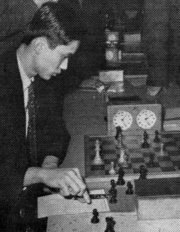
Tan, to be sure, quickly surpassed Schilp too, and was
the first in the Netherlands to obtain a Dan in go. Tragically, a mental
breakdown in early 1963 put an end to his careers in both games. At 24, he was
repatriated to his native Indonesia where he is supposed to be still living in
Bandung - but his Dutch chess friends never saw him again.
Another player in that telltale match was Max Rebattu, a
very strong chess player and a top bridge-player.
After Tan's disappearance, Rebattu soon became Holland's best go-player, winning
the Dutch Championship seven times between 1963 and 1977 - every time it was held
during those years. He eventually made it to Fifth Dan. As a bridge player,
he won silver at an Olympiad, and barely missed a World Championship on one occasion.
It's all in the same old hemisphere.
Hoan Liong Tan might have gone far as a chess player - he was the first Indonesian
who became an International Master, and playing for Indonesia at the Leipzig 1960
Olympiad, he won the gold medal on board 4, with 16.5 from 20.
Tan - Averbakh, Beverwijk 1963
1.d4 Nf6 2.c4 e6 3.Nf3 Bb4+ 4.Nbd2 d5 5.a3 Be7 6.Qc2 Nc6 7.e3 a5 8.b3
O-O 9.Bb2 Bd7 10.Be2 a4 11.b4 dxc4 12.Nxc4 Na7 13.Nfe5 Bb5 14.O-O c6 15.
Rfd1 Nc8 16.Bf3 Nd6 17.Nd2 Nd5 18.Nd3 Bg5 19.Re1 Nb6 20.Nc5 Qc7 21.Nb1
Rfe8 22.Nc3 Bf6 23.Rad1 Nbc4 24.Bc1 Ra7 25.Be2 b6 26.N5e4 Be7 27.Bd3 h6
28.Qe2 Nxe4 29.Nxe4 Nd6 30.Nxd6 Bxd6 31.Bxb5 cxb5 32.Qxb5 Bxh2+ 33.Kf1
Rd8 34.e4 Bd6 35.Be3 Bf8 36.d5 exd5 37.Rxd5 Rxd5 38.exd5 Rb7 39.Qc6 Qb8
40.Rd1 Bd6 41.Qxa4 Ra7 42.Qc6 Rxa3 43.Qxb6 Qxb6 44.Bxb6 Rc3 45.Bd4 Rc4
46.b5 Rb4 47.b6 Rb5 48.Be3 Kf8 49.g4 Ke7 50.Kg2 g6 51.Kf3 f5 52.gxf5
gxf5 53.Rh1 Rxd5 54.Rxh6 Rb5 (see diagram) 55.b7
Black did not see the threat; after 55...Rb3(?) 56.Rxd6 he resigned.
He was lost anyway: 55...Be5 56.Rb6 Rxb6 57.Bxb6 Bb8 58.Be3 followed by Bf4,
or 55...Bb8, 56.Rb6 Ra5 57.Rb3 (to be able to play Bf4 without being disturbed by
a check by Ra3+) 57...Ra4 58.Rc3 f4 59.Bb6 Ra6 60.Rc8 Rxb6 61.Rxb8 Kd7 62.Rh7 etc.
PS 7 June: Joshua Green supposed go-programming is more difficult
than chess-programming not so much because of the greater number
of possible moves, as because "it's not so easy to come up with a good
evaluation function. In chess, simply counting material gives a reasonable
evaluation, but in go, as far as I know, no analogous method exists."
This was confirmed by William Harold Newman,
"a tolerable coffeehouse chess player, a 3 dan Go player, and author of
several experimental Go-playing computer programs".
"Computer programs," writes Newman, "are still weak Go
players even on 9x9 boards, where the number of available moves is
comparable to the number of moves in Chess. I think a more important
factor in the relative weakness of computer Go programs is that in
Chess you can count pieces and mobility to get a crude but usable
first-order approximation of how good a position is for you, while in
Go no comparably good approximation has ever been found."
On the transfer of skill from chess to go, Newman
writes: "While I think some Chess skill does transfer to Go, I would be
rather surprised to see a Chess player play Go for a week or two and
then beat an experienced modern Go player. (...) However, last year,
I personally saw the progress of a Chess [USCF-2340 player] learning Go.
He learned considerably faster than anyone else I've seen, but after
several months he was still around 10 kyu, no match for any but the very
weakest regular club players."
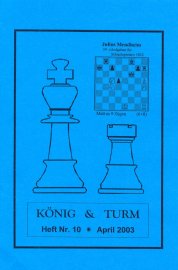 213. 10 May 2003:
A double double square vacation
213. 10 May 2003:
A double double square vacation
In the April issue of Hanspeter Suwe's König & Turm, a magazine devoted exclusively to castling, I found (René Olthof found, and tipped me) a problem by Andreas Thoma showing the first double double square vacation by castling.
But first some history.
Sam Loyd
Mate in 4
The American Chess Journal 1877
The first to show that castling has the peculiar property of vacating two squares at once, was Sam Loyd, be it in an illegal position.
After moves by Ra1, Na1-b3-c5 mate is threatened, but axb5 followed by bxa4 defends.
And after king moves, threatening Ne1-d3-c5 mate, f5 followed by fxe4 defends.
Therefore: 1.0-0-0! and now 1...axb5 2.Ne1! and 4.Nc5 mate,
or 1...f5 2.Na1! and 4.Nc5 mate.
T.R. Dawson
Mate in 3
The Chess Amateur 1923
Loyd's idea, with a Queen as the thematic piece, and on the other side of the board, was shown more elegantly and economically by T.R. Dawson.
1.K- is parried by c5! and 1.R-1 by b3!
Therefore: 1.0-0! and now 1...b3 2.Qe1! or 1...c5 2.Qh1!
Dawson, and others, also showed serial square vacations by castling, by one or
by two pieces, an idea that lives to this day, as I discovered when judging my
jubilee moremover tourney.
Mate in 5
Chris Handloser
Special Commendation, Tim Krabbé 60-JT 2003
1.0-0! h5 2.Ne1 h4 3.Bh1 h3 4.Nf3 Kc6 5.Nd4 mate.
Amazingly, among his collection of approximately 20000 castling problems,
Suwe did not find an anticipation of this combination of two ancient ideas;
Loyd's castling idea of 1877, and Loveday's Indian theme of 1845.
And now, the double double square vacation has been shown by Andreas Thoma.
Mate in 4
Andreas Thoma
König & Turm, April 2003
After the key 1.Ba4, 2.Nb4 and 3.Na6 mate is threatened. Black has two
defences:
a) 1...d5 Now 2.K- (threatening Qe1-a5 mate) fails to 2...dxc4. Therefore:
2.0-0! and now 2...any 3.Qe1! and 4.Qa5(b4) mate, or
2...dxc4 3.Qh1! and 4.Qxc6 mate
b) 1...a5 Now 2.K- with the threat Qe1-a5 mate fails to 2...Nf7 and Nd6.
Therefore: 2.0-0-0! followed by 3.Qe1 and 4.Qa5 mate,
except after 2...Nf7 when 3.Na1! and 4.Nb3 is mate.
König & Turm appears three times a year for a subscription fee of € 17,50.
For information, contact Hanspeter Suwe.
212. 27 April 2003: Mobility & game-series-helpmate records
In entry 195, maximum mobility was discussed, defined as the "greatest
number of legal moves in game positions". The records found were 69 in a simul
game, and 71 in a tournament game, the latter with a promoted queen and
promotion moves being possible.
When I mentioned this in
my Dutch newspaper column, I added that new records would have to be found
'by hand', because computers cannot help here.
Chess programmer Gian-Carlo Pascutto did not agree and, modifying his program
Deep Sjeng, found the following game.
Podhorzer - Palda, XVI Trebitsch-Turnier, Vienna 1933
1.d4 d5 2.Nf3 Nf6 3.c4 e6 4.Nc3 c6 5.e3 Be7 6.Bd3 Nbd7 7.O-O O-O 8.Qe2 Qc7
9.e4 dxe4 10.Nxe4 Nxe4 11.Bxe4 Bf6 12.Re1 Re8 13.Ne5 g6 14.Bf4 Qb6 15.Rad1
Qa5 16.Nxc6 Qxa2 17.Ra1 Qb3 18.Ra3 Qb6 19.c5 Nxc5 20.dxc5 Qxc5
21.Rc1 Qb6 22.Ne5 Qd6 23.Qb5 Qf8 24.Ng4 Bg7 (see diagram)
White has 75 moves here - without promoted pieces and without
promotion moves. After 25.Bd6 Re7 26.Qc5 Black resigned.
Another record I treated in that column was a construction task;
the quickest 'game series-helpmate'.
From the initial position, White makes a series of moves, after which Black
must be able to mate him in 1. Checks and captures are not allowed.
I mentioned that Richard Stanley had
done this in 8 moves (1.c3 2.Qa4 7.Ka5 8.b4, and now c6 mate)
(but see the PS to this entry)
but almost immediately, two readers reacted.
Martin van Essen showed
several other solutions in 8 moves, on both sides and in the middle of the board:
1.f3 5.Kh5 7.Ng5 8.h4 Nf6 mate
1.e4 6.Ka5 7.a4 8.Bb5 c5 mate
2.b5 3.c4 4.d4 8.Kc5 e6 mate
1.e4 2.f4 4.g5 8.Kf5 d6 mate
1.f4 2.g4 4.h5 8.Kg5 e6 mate
But Joost Retera smashed the record with
1.d4 5.Ka5 6.a4 7.b4 (see diagram) c6 mate.
PS 29 April: My apologies to Richard Stanley for having misrepresented
his intentions with his 8-move game. That was a proof game; a game where
every move has to be unique and no moves can be interchanged. In all other
examples, this is possible. Stanley also points out (other readers did,
too) that with captures, there are many 6-move solutions, all based on
the Fool's Mate, e.g. 1.g4 2.f4 5.fxe7 6.exf8B Qh4 mate, or 3.Nxe7
4.Nc6 5.f3 6.g4 Qh4 mate, evidently none of them being a proof game.
211. 20 April 2003: Tour de Tim Krabbé
 |
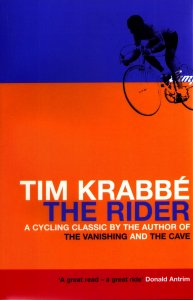 |
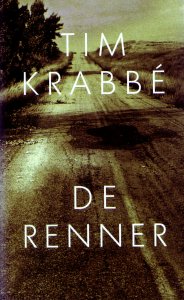 |
At the occasion of the 25-year jubilee of my novel De Renner (from l. to r.: first printing; 2002 Bloomsbury translation; jubilee edition) a Tour de Tim Krabbé will be held from 9-15 June, in the Cevennes in Southern France. It is a week of gorgeous randonnees over the routes where I once trained and raced, culminating in a 140-kms. ride over the course of the race described in the book. A few participants can still be accepted. Click, or mail me.
210. 13 April 2003: TK-60 JT Awards
I've loved numbers all my life, and only today I discover that 60 immediately
follows 19?
Here are the (provisional, as always in composing tourneys)
winners in the Tim Krabbé-60 Jubilee Tourney, with sections for endgame studies
and for direct-mate moremover problems.
| White to play and win
Emil Melnichenko First Prize, TK-60 JT 2003 |
Mate in 14
Andrzej Jasik First Prize, TK-60 JT 2003 |
Links to the full reports with all the awarded compositions and their solutions:
Studies (Nederlands)
(English)
Meerzetten |
Moremovers

Emil Melnichenko, New Zealand, (provisional) winner in the studies section.
209. 9 April 2003: A female theme
Mate in 10
When I chanced upon this problem, and looked at the solution, I couldn't help laughing aloud.
1.f4 Nc3 2.Qa6+ Nb5 3.f5 Bd2 4.Qa4+ Bb4 5.f6 Nc3 6.Qa6+ Nb5 7.f7 Bd2 8.Qa4+ Bb4 9.f8Q and now 9...Nc3 10.Qxc5 mate or 9...Nd6 10.Qf1 mate.
This reminded me of a mother, sitting in a park with two naughty children who run
away in turn, and she has to get up all the time and run after them, and bring
them back.
"A female theme, if there ever was one," I thought,
and only then did I see that this problem, which was published in 1977 in
Freie Presse, was by Nadezhda Leontyeva. She was a
top Soviet chess composer in the sixties and seventies, but all I can find are some
of her (all very witty) problems and studies and, in a 1990 Soviet
chess encyclopedia, her birth year, 1928.
She was a Candidate Master of Sports and published a
problem book, but I'd like to know more about her.
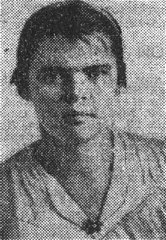 PS 11 April: Harold van der Heijden sends me an excerpt about Leontyeva from
Zoilo Caputto's El arte del estudio de ajedrez; volume 4 about Soviet
composers. As this is from 2000, and Van der Heijden vows for Caputto's accuracy,
she was alive by then - might very well live today. Leontyeva (easily the best
female composer ever - I know about Mrs. Baird) lived in Rovno in the Ukraine. She
composed a few studies and some 250 problems, eight of which won First Prizes,
several making it to that Valhalla of artistic chess, the FIDE-albums. She is
supposed to be the originator of the Rovno theme, but I don't know
what that is.
PS 11 April: Harold van der Heijden sends me an excerpt about Leontyeva from
Zoilo Caputto's El arte del estudio de ajedrez; volume 4 about Soviet
composers. As this is from 2000, and Van der Heijden vows for Caputto's accuracy,
she was alive by then - might very well live today. Leontyeva (easily the best
female composer ever - I know about Mrs. Baird) lived in Rovno in the Ukraine. She
composed a few studies and some 250 problems, eight of which won First Prizes,
several making it to that Valhalla of artistic chess, the FIDE-albums. She is
supposed to be the originator of the Rovno theme, but I don't know
what that is.
Another detail about her might have made me think twice
about that image of a woman in a park, running after her children. From 1956 on,
when she was 28, Leontyeva lived on a handicapped person's Social Security.
Perhaps she couldn't run. But then again - her compositions reveal such a sense
of humour that I'm sure she wouldn't have been offended. In fact, it is tempting to
think that in her chess ideas, she sought compensation for a restricted life -
there is such agility in them.
White to play and win
Nadezhda Leontyeva
Shakhmatyi v SSSR, 1973
Without Bh1 and Pg6, 1.Nf3 would be mate. 1.Qg7+ Ke4 2.Qxg6+ Ke5 3.Qg7+ Ke4
4.Qh7+ Ke5 5.Qh8+ Ke4 6.Qa8+ Ke5 7.Qa1+ Ke4 8.Qxh1+ Ke5 9.Qa1+ Ke4 10.Qa8+ Ke5
11.Qh8+ Ke4 12.Qh7+ Ke5 and the position has undergone the desired
alterations: 13.Nf3 mate.
Mate in 4
Nadezhda Leontyeva
1st Prize Novi temi, 1977
1.g7 and now:
1...Bxg7 2.Rxc5+ Kxf6 3.Rc6+ Ke5 4.Qc5 mate
1...Nxg7 2.Bxf4+ Kxf6 3.Bg5+ Ke5 4.Qf4 mate
Here, I see a cowboy lassoing two calves, and then tying them up. But perhaps
there is too much Rorschach in my schach, and too few rodeo's in the Ukraine.
PS 29 June: Thanks to Joost de Heer for letting me know that just
now, a "Nadezhda Leontyeva - 75 composition tourney" was announced, to be judged by herself.
Her 75th birthday will be 1 August 2003. So, she's still alive and
healthy - congratulations.
208. 6 April 2003: From the vacation home of the Halloween Gambit
Some time ago, I wrote about the Halloween Gambit (1.e4 e5 2.Nc3 Nf6 3.Nf3 Nc6 4.Nxe5)
correspondence Tournament,
organised by its revivor, Maurits Wind. (See Open Chess
Diary, item 197.)
This tournament is now under way with
thirteen participants, who have an average FIDE
rating of 2229. Among them, GM Milov, IMs Starostits and Jerez,
FMs Torrecillas and Jeroen Blokhuis. Before the tournament started, Wind asked
the participants about White's chances. Their estimates varied from 50 % to 25 %.
The first games being finished now, White leads
with 70 % (+2 =3 -0).
PS 16 April:
After 20 games, Torrecillas' remark is of course confirmed. The score is now
+4 =11 -5 or 47.5 % for White. Not bad.
Hoynck (2043) - Werksma (2196)
1.e4 e5 2.Nf3 Nc6 3.Nc3 Nf6 4.Nxe5 Nxe5 5.d4 Nc6 5.d5 Nb8 7.e5 Ng8
8.d6 cxd6 9.exd6 Qa5 10.Bb5 Qb4 11.0-0 Qxd6 12.Re1+ Kd8 13.Qf3 Nf6 14.Bf4 Qc5
15.Re5 Qb6 16.Bg5 h6 17.Nd5 Qd6 18.Rae1 Be7 19.Bxf6 Bxf6 (see diagram)
20.Qg3 Bxe5 21.Rxe5 Na6 22.Re8+ Rxe8 23.Qxd6 Re1+ 24.Bf1 Ke8
25.Qg3 Kf8 26.f4 Re8 27.f5 f6 28.Qd6+ Kg8
29.Bc4 Kh8 30.Nxf6 and Black resigned.
Milov (2574) - Hoynck
1.e4 e5 2.Nf3 Nc6 3.Nc3 Nf6 4.Nxe5 Nxe5 5.d4 Ng6 6.e5 Ng8 7.Bc4 d6 8.Qf3 Qd7
9.0-0 dxe5 10.dxe5 Nxe5 11.Re1 Bd6 12.Bf4 f6 13.Bb5 c6 14.Rad1 Qe6 15.Qg3 Kf8
16.Ne4 Bc7 (see diagram) 17.Ng5 Qf5 18.Bxe5 fxe5 19.Bc4 Qg4
20.Qxg4 Bxg4 21.f3 Bc8 22.Nf7 Nh6
23.Nxe5 g6 24.Nd7+ Bxd7 25.Rxd7 Ba5 26.Re6 Rb8 27.Kf1 Bd8 28.Re4 b5 29.Be6 a5
30.c4 Ng8 31.Bxg8 Rxg8 32.Rxh7 Rg7 33.Rh8+ Rg8 34.Rh7 draw
Starostits (2398) - Keiser (1932)
1.e4 e5 2.Nc3 Nf6 3.Nf3 Nc6 4.Nxe5 Nxe5 5.d4 Ng6 6.e5 Ng8 7.Bc4 d5 8.Bxd5 c6
9.Bb3 Be6 10.0-0 Bxb3 11.axb3 N8e7 12.Ne4 Nf5 13.c3 Qd7 14.g4 Nfh4 15.f4 h5
16.f5 Nxe5 17.g5 Qd5 18.Qe2 Nef3+ 19.Rxf3 Nxf3+ 20.Qxf3 a6 21.b4 0-0-0 22.Ra5 Qb3
23.Qe2 Bd6 24.Nxd6+ Rxd6 25.Bf4 Rdd8 26.Qe5 Qd1+ 27.Kg2 (see diagram)
Rd6 28.Qxd6 draw.
PS 9 April:
One of the participants, Antonio Torrecillas, remarks that this early 70 %
is not significant, mainly because White wins will tend to be short attacking
games, while Black wins will tend to be long games where a material advantage
is slowly converted.
I was aware of this bias - but the fact that at any
point in a correspondence tournament with this opening between strong players,
White could lead by such a margin, struck me. More later.
207. 13 March 2003: Fischer's bitter disappointment anticipated
One of Fischer's great disappointments came in Robert Byrne - Fischer, New York
1963, ch USA - one of his most famous games, and the famous championship he won
with 11 out of 11.
When White resigned in the position on the left, Fischer
wrote in My 60 Memorable Games: "A bitter disappointment. I'd hoped for 22.Qf2 Qh3+
23.Kg1 Re1+!! 24.Rxe1 Bxd4 with mate to follow shortly."
Recently, I found an anticipation of this combination by the nobleman who
is supposed to have paid players to lose brilliantly against him.
Prince Dadian of Mingrelia - Kogan, Kiev 1902
1.e4 e5 2.Nf3 Nc6 3.Bc4 Bc5 4.b4 Bxb4 5.c3 Ba5 6.d4 exd4 7.O-O dxc3 8.Qb3 Qf6
9.e5 Qg6 10.Nxc3 Bxc3 11.Qxc3 Nge7 12.Re1 b6 13.Bd3 Qh5 14.e6 O-O 15.Bb2 f6
16.Be4 Qe8 17.Ng5 g6 18.Qh3 fxg5 19.Qh6 Rf7 20.exf7+ Qxf7 (see diagram)
21.Bd5 Nxd5 22.Re8+ Qxe8 23.Qg7 mate.
206. 9 March 2003: How Jinky Young came into the world
In May 2000 Robert Nemenyi, a 57-year old Hungarian-American Jew, arrived
in the Philippines, fresh from a Japanese jail, where he had spent some
time after being caught at Narita Airport with some hemp he had tried to import from
Germany.
He was looking for a woman who would cooperate in fulfilling
his long-felt wish to perpetuate his genes. Eight years earlier, Nemenyi's genes
had almost returned to their roots when he impregnated a young Hungarian
woman (heavens no, not one of them), but on second thought, she had
gotten rid of these genes.
This time however, a Filipino friend of Nemenyi's,
whom we will call Gene for the occasion, set him up in a cottage in Baguio
City, and presented him with a series of willing gene-carriers, from whom
Nemenyi chose 22-year old Justine Young. A contract was signed, Justine received
the genes, and nine months later she gave birth to a girl, who now grows
up in Davao City, under the name of Jinky Young.
PS 5 May 2009: Originally, this item was titled: 'How Jinky Ong came into the world.' However, chessgames.com suggested this might be mistaken and the mother's name might be Marilyn Young. Checking this with my informant, I found that he indeed made a mistake with the surname, which is in fact Young. But her first name is Justine. So they're Justine Young, and Jinky Young.
205. 5 March 2003: Plachutta's only game
Browsing Probleme, Studien und Partien 1862-1912 by Johann Berger (1845-1933), the Austrian player, endgame theorist, study composer, but foremost dogmatist of the early German school of problem composition (the title of his manifesto, Das Schachproblem, und dessen kunstgerechte Darstellung is better left untranslated), I came across this offhand game:
Berger - Plachutta
Graz, 1866
This is perhaps the only surviving game by Josef Plachutta (1827-1883), one of the early
greats of problem history, whose name lives on (see below) in the move he invented.
1.e4 e5 2.Nf3 Nc6 3.Bb5 Nf6 4.O-O Nxe4 5.d4 Be7 6.Qe2 Nd6 7.Bxc6 dxc6
Here, Berger writes: "Around 1866, the great problem master was stationed in Graz for
a while as a military official; he was a strong player too, but not very well versed
in theory. Therefore, he did not know yet L. Paulsen's attacking combination which now
follows."
8.dxe5 Nf5 9.Rd1 Bd7 10.e6 fxe6 11.Ne5 Bd6 12.Qh5+ g6 13.Nxg6 Ng7 14.Qh6 Nf5
15.Qh3 (see diagram)
It is surprising that this position has survived until almost today. Berger points at
15...Rg8 - which (after the repetition 15...Ng7 16.Qh6 Nf5 17.Qh3 Rg8) led to a draw in
Ivkov - Trifunovic, Sarajevo 1963: 18.Qxh7 Rg7 19.Qh5 Qf6 20.Ne5+ (without
the repetition, 18.Nf4+ led to a quick win after 18...Ke7 19.Nc3 Bxf4 20.Bxf4 Rh8??
21.Ne4 Be8 22.Bg5 1-0 in Hübner - Vogel, Germany tt 1986) Ke7 21.Ng4 Qg6
22.Qxg6 Rxg6 23.h3 e5 24.Nc3 Nd4 25.Ne4 Bxg4 26.hxg4 Nxc2 27.Bg5+ Rxg5 28.Nxg5 Nxa1
29.Rxa1 Rg8 30.Ne4 Rxg4 31.f3 Rh4 32.g4 Ke6 33.Kg2 Be7 34.Kg3 Rh8 35.Rd1 Bh4+ 36.Kg2 Be7
37. Kg3 Bh4+ (˝-˝)
Berger - Plachutta continued: 15...Qf6? 16.Nxh8 Qxh8 17.Qh5+ Kf8 18.Nc3 Be8
19.Bh6+ Nxh6 20.Qxh6+ Ke7 21.Rd3 Bg6 22.Rf3 Rg8
23.Re1 Be5 24.Qg5+ Bf6 25.Qc5+ Kf7 (see diagram) and now the simple but
picturesque 26.Nd5! Bf5 27.Rxf5 exf5 28.Re7+ Bxe7 29.Qxe7+ Kg6 30.Qe6+ Kg5 31.f4+
and Black resigned.
Plachutta's historic problem:
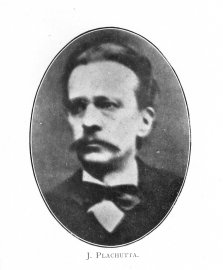
Mate in 4
J. Plachutta
Leipziger Illustrirte Zeitung, 1858
After 1.Qf3 Nxc5 (the sort of unthematic introduction that was in fashion at the
time and, strangely, still is in endgame studies), there follows the
proto-Plachutta: 2.Rg7! The double threat of Qg3+ and Bc7+ then leads,
according to the thematic interferences and decoys, to two variations:
2...Rgxg7 3.Bc7+ Rxc7 4.Qg3 mate
2...Rhxg7 3.Qg3+ Rxg3 4.Bc7 mate
204. 13 February 2003: A classic retractor
A reader asks me if I know this position. Sure, it is a classic gem, but it is perhaps
also the classic authorless problem - I have often seen it quoted with "Source ?"
underneath.
It is a composition by M. Adabashev, from
"64", 1938, and it is a quadruplet retractor: White retracts his last
move, and instead mates in 1.
a) in the diagram
b) with all pieces one rank up
c) with all pieces two ranks up
d) with all pieces three ranks up
Each position has a different and unique solution that is as easy to find as
the whole thing is witty.
203. 6 February 2003: Campomanes goes to jail
News sources in the Philippines report that former FIDE President and Honorary FIDE
President Florencio Campomanes was convicted yesterday by the Sandiganbayan, the
anti-graft Court, for "failure to account for government funds" amounting to 12,8 million
Philippine pesos, or $ 238,745.
This was money the Philippine Sports Commission entrusted
to Campomanes to be used by FIDE for the World Chess Olympiad in Manila in 1992. In
January 1994, when an audit revealed that the money had not reached FIDE, Campomanes was
asked to refund the sum, or to make clear where it had gone. He has never done either.
Campomanes was sentenced to one year and 10 months imprisonment.
202. 31 January 2003: Eight new World Champions
In the issue of Probleemblad that I received today, I found three absolutely
marvelous problems.
The first won the First Prize in the magazine's 2001 selfmate
competition.
Selfmate in 17
L. Perrone
1st Prize Probleemblad, 2001
If this position were a girl, she'd be called a real looker. "Outshining all other
stars of that year," the judge writes, wishing this "masterpiece" will be reproduced many
times.
You'd wonder how White is ever going to be mated at all, but here
is the excruciatingly
funny way it is done: 1.g7+ Ke8 2.f7+ Kd8 3.e7+ Kc8 4.d7+ Kb8 5.c7+ Ka8 6.b7+ Ka7
and now six pawns promote to Queen and Bishop in turn: 7.b8Q+ Kxa6
8.c8B+ Ka5 9.d8Q+ Ka4 10.e8B+ Ka3 11.f8Q+ Kb2 12.g8B Now Black must do as White
wishes. 12...Kc3 13.Qc2+ You go here. 13...Bxc2 14.Rxd3+ Bxd3 15.Qd4+ Kxd4
16.Qe5+ Kxe5 And now you go away from there: 17.Qf4+ Kxf4 mate.
In the final position, all the promoted Queens have vanished,
while all the promoted Bishops, like Jane Gallagher's Kings, have remained on their
promotion squares.
The third prize too, was very nice.
Selfmate in 27
S. Smotrov
3rd Prize Probleemblad, 2001
Here, Bf2+ would force Black to mate with Rxf2, were it not for Bd7's interference. How
to get it out of the way? The elaborate procedure by which this is done, reminds me of a
Japanese cook who will juggle for hours with knives, spoons, pots and pans at your teppan
yaki table, only to put everything back in the end, and serve you one tiny bite of food.
First, the other Bishop has to make room for the Knight:
1.Bc3+ Kc4 2.Bd2+ Kd4 Now, the Knight takes its place:
3.Nc6+ Kd3 4.Ne5+ Kd4 5.Nf3+ Kd3 6.Ne1+ Kd4 Next, the Bishop makes room for the Rook
and changes from front piece to tail piece of a battery: 7.Bc3+ Kc4 8.Ba5+ Kd4
9.Nf3+ Kd3 10.Rd2+ Kc4 11.Rb4+ Kc3 12.Rb6+ Kc4 In turn, this Rook has changed from
front piece to tail piece in the battery that finally does the trick. 13.Bb5+ Kb3
14.Be8+ There he is. On other squares, he would be in the way. Now all the helpers
hurry back the way they came. 14...Kc4 15.Rb4+ Kc3
16.Rbb2+ Kc4 17.Rdc2+ Kd3 18.Ne1+ Kd4 19.Bc3+ Kc4 20.Bd2+ Kd4 21.Nf3+ Kd3 22.Ne5+ Kd4
23.Nc6+ Kd3 24.Nb4+ Kd4 25.Bc3+ Kc4 26.Be1+ Kd4 and we are back in the initial
position, only with Bd7 on e8. So: 27.Bf2+ Rxf2 mate
I also discovered there are eight new World Champions of Chess Composition. The tourney
which they won was for compositions that had already been published in the period of
1998-2000. The champions are:
Two-movers: Chepizhni (Russia)
Three-movers: Marandyuk (Ukraine)
More-movers: Marandyuk (Ukraine)
Studies: Gurgenidze (Georgia)
Helpmates: Janevski (Macedonia)
Selfmates: Petkov (Bulgaria)
Fairy's: Petkov (Bulgaria)
Retro's: Kislyak (Ukraine)
This is the World Champion more-mover:
Mate in 7
Mikhial Marandyuk
1st Prize, Feoktiskov 50-JT, 1998
The attempt to mate with 1.Nd7 and 2.Nb6 is thwarted by Bf2. Another attempt, 1.Rd7
intending 2.Rxd6 mate, fails to e4. If then 2.Rc7 (the 4th rank closed, 3.Bxc4 would now
be mate) Black does not oblige with 2...e3 which would close the diagonal f2-b6
and enable 3.Nd7 and 4.Nb6 mate, but stops the whole mechanism with 2...Be2.
Therefore: 1.Bd7 f4 Forced. Now the switchback 2.Bb5
is a double threat: Bxc4 mate and Rd7 with mate next move. Pieces can go back,
but pawns can't, so Black can only clear the 4th rank and the g3-d6 diagonal with
2...f3 This, however, deprives Black of his defence Be2, so now the old plan
works: 3.Rd7 e4 Opens the diagonal to d6, but closes the 4th rank once more. So:
4.Rc7 e3 Be2 being unavailable, the 4th rank had to be cleared yet again, but this
time the f2-b6 diagonal is fatally clogged: 5.Nd7 Rd4 6.Bxc4+ Rxc4 7.Nb6 mate.
The way in which d7 is used by two pieces for a switchback, and
by a third for the mate, and all the little trapdoors on the 4th rank and the diagonals
opening and shutting again - all in a logical sequence of plans, is wonderful, worthy of
a world champion indeed.
201. 30 January 2003: Babsonmania
In "64" of October 2002, Yakov
Vladimirov wrote (thanks to Steve Giddins for tipping me and translating for me) that only
G. Sakharov (see diagram; mate in 4) had created a "Perfect Babson Task",
that is, one "where both pawns promote without capture".
It was the first, but for over a decade, there have been
four such positions. See my new article
Sons of Babson,
in which I give all (fifteen) direct-mate Babson Tasks without promoted pieces in the
initial position.
© Tim Krabbé, 2003
Previous entries |
Next entries |
Current Open Chess Diary
Top |
Main chess page |
Main page |
Contact me